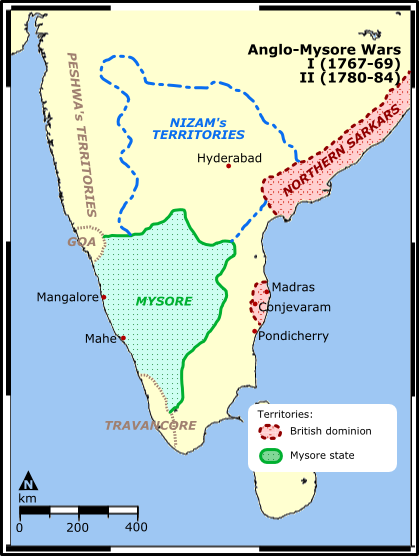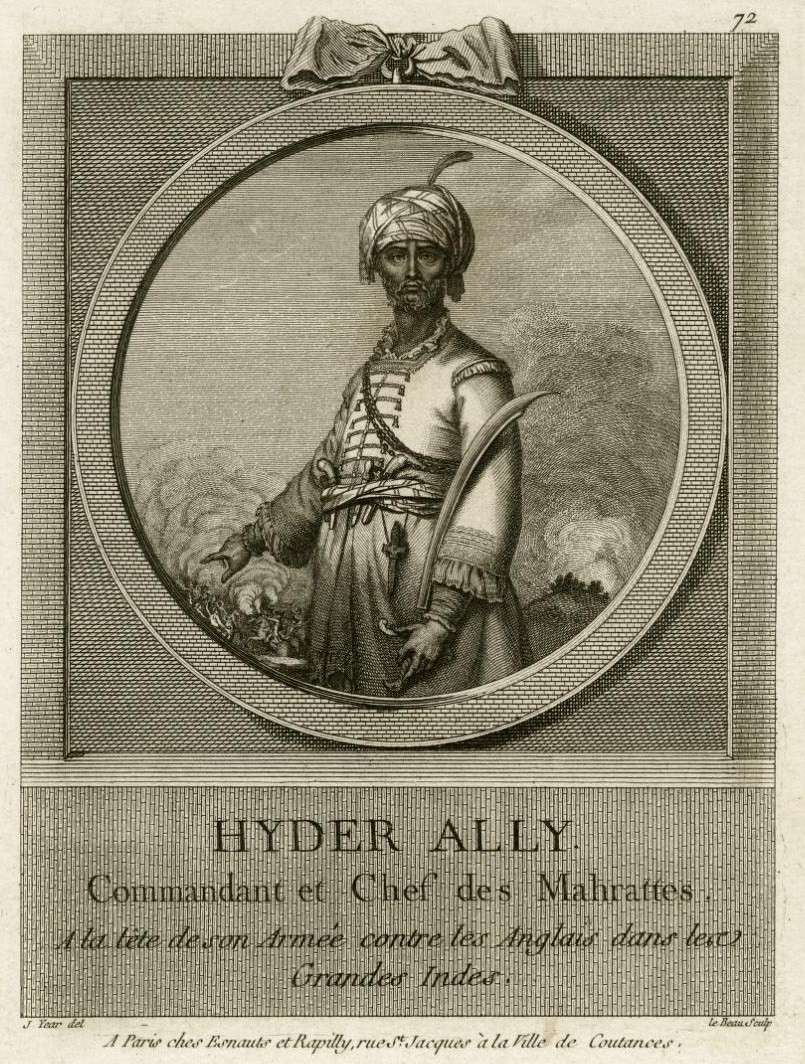|
Mysore Invasion Of Kerala
The Mysorean invasion of Malabar (1766 –1792) was the military invasion of the Malabar region of Kerala, including the territories of the Zamorin of Calicut, by the then-''de facto'' ruler of the Kingdom of Mysore, Hyder Ali. After the invasion, the Kingdom of Cochin to the south of Malabar became a tributary state of Mysore. The invasion of Malabar was motivated by a desire for access to the ports bordering the Indian Ocean. The Mysore invasion gave the East India Company the opportunity to tighten their grip on the ancient feudal principalities of Malabar and convert Travancore into only a protected ally. www.kerala.gov.in History By the late 18th century, the small kingdoms had been absorbed or subordinated by three large states: Travancore, Calicut (ruled by Zamorins), and the Kingdom of Cochin. The Kingdom of Mysore, ruled nominally by the Wodeyar family, rose to prominence in India after the decline of the Vijayanagara Empire and again after the Mughal Empire. In 1761 ... [...More Info...] [...Related Items...] OR: [Wikipedia] [Google] [Baidu] |
Anglo-Mysore Wars
The Anglo-Mysore Wars were a series of four wars fought during the last three decades of the 18th century between the Kingdom of Mysore#Under Haider Ali and Tipu Sultan, Sultanate of Mysore on the one hand, and the British East India Company (represented chiefly by the neighbouring Madras Presidency), Maratha Empire, Kingdom of Travancore, and the Hyderabad State, Kingdom of Hyderabad on the other. Hyder Ali and his succeeding son Tipu Sultan, Tipu fought the wars on four fronts: with the British attacking from the west, south and east and the Nizam of Hyderabad, Nizam's forces attacking from the north. The Fourth Anglo-Mysore War, fourth war resulted in the overthrow of the house of Hyder Ali and Tipu (the latter was killed in the fourth war, in 1799), and the dismantlement of Mysore to the benefit of the East India Company, which Company rule in India, took control of much of the Indian subcontinent. The four wars First Anglo-Mysore War The First Anglo-Mysore War (1767 ... [...More Info...] [...Related Items...] OR: [Wikipedia] [Google] [Baidu] |
Indian Ocean
The Indian Ocean is the third-largest of the world's five oceanic divisions, covering or ~19.8% of the water on Earth's surface. It is bounded by Asia to the north, Africa to the west and Australia to the east. To the south it is bounded by the Southern Ocean or Antarctica, depending on the definition in use. Along its core, the Indian Ocean has some large marginal or regional seas such as the Arabian Sea, Laccadive Sea, Bay of Bengal, and Andaman Sea. Etymology The Indian Ocean has been known by its present name since at least 1515 when the Latin form ''Oceanus Orientalis Indicus'' ("Indian Eastern Ocean") is attested, named after Indian subcontinent, India, which projects into it. It was earlier known as the ''Eastern Ocean'', a term that was still in use during the mid-18th century (see map), as opposed to the ''Western Ocean'' (Atlantic Ocean, Atlantic) before the Pacific Ocean, Pacific was surmised. Conversely, Ming treasure voyages, Chinese explorers in the Indian Oce ... [...More Info...] [...Related Items...] OR: [Wikipedia] [Google] [Baidu] |
Palakkad
Palakkad (), formerly known as Palghat, historically known as Palakkattussery is a city and municipality in the Indian state of Kerala. It is the administrative headquarters of the Palakkad District. Palakkad is most densely populated municipality and fourth densely populated city in Kerala. It was established before Indian independence under British rule and was known by the name Palghat. Palakkad is famous for the ancient Palakkad Fort, which is situated at the heart of the city and was captured and rebuilt by Hyder Ali in 1766. The city is situated about northeast of the state capital Thiruvananthapuram. The 18th-century Palakkad Fort has sturdy battlements, a moat, and a Hanuman temple on its grounds. North on the Kalpathy River, the 15th-century Viswanatha Swamy Temple is the main venue of the Ratholsavam chariot festival.The river Bharathappuzha flows through Palakkad. Palakkad is located on the northern bank of Bharathappuzha River. Palakkad was included in the South ... [...More Info...] [...Related Items...] OR: [Wikipedia] [Google] [Baidu] |
Valluvanad (southern Malabar)
Valluvanad was an independent chiefdom in present-day central Kerala that held power from the early 12th century to the end of the 18th century. Prior to that, and since the late 10th century, Valluvanad existed as an autonomous chiefdom within the kingdom of the Chera Perumals.Ganesh, K. N. (2009). Historical Geography of Natu in South India with Special Reference to Kerala. Indian Historical Review, 36(1), 3–21. The disintegration of the Chera Perumal kingdom in early 12th century led to the independence of the various autonomous chiefdoms of the kingdom, Valluvanad being one of them. The earliest mention of the term "Valluvanad" as a political entity, from the 9th and early 10th century, are references to a region within the Ay kingdom in the south Kerala, then a vassal to the Pandya kingdom. It is possible that the new chiefdom in central Kerala (within the kingdom of the Chera Perumals) derives its origin from this eponymous subdivision in south Kerala. Valluvanad was rule ... [...More Info...] [...Related Items...] OR: [Wikipedia] [Google] [Baidu] |
Kadathanad
Kadathanadu (Vatakara) was a former feudatory (of Kolathunad) city-state in present-day Kerala, on the Malabar Coast. The region is most known for being the area where the events of the ''Vadakkan Pattukal,'' a set of warrior ballads from Kerala, took place, and for being one of the heartlands of Kerala's native martial art, Kalarippayattu. Geographical location Geographically, ''Kadathanadu'' is situated to the south of Thalassery and north of Koyilandy on the Malabar coast, beside the historical Kotakkal river. The area roughly six kilometers from Vatakara is known as ''Kadathanadu''. The place is now part of Puduppanam in Vatakara. ''Kadathanadu'', apart from its cultural richness, is also the site of a famous Hindu temple, the Lokanarkavu temple. History The erstwhile princely state of ''Kadathanadu'' was ruled by Rajas of ''Kadathanadu also known as Kadathanadttu Raja'', who were of Nair origin and was feudatories to the Kolathiri. Around 1750, the ruler of ''Kadathanadu'' ... [...More Info...] [...Related Items...] OR: [Wikipedia] [Google] [Baidu] |
Kottayam
Kottayam () is a municipal town in the Indian state of Kerala. Flanked by the Western Ghats on the east and the Vembanad Lake and paddy fields of Kuttanad on the west. It is the district headquarters of Kottayam district, located in south-west Kerala. Kottayam is located in the basin of the Meenachil River at an average elevation of above sea level, and has a moderate climate. It is located approximately north of the state capital Thiruvananthapuram. Kottayam is also referred to as "The City of Letters" as many of the first Malayalam daily newspapers, like '' Deepika,'' ''Malayala Manorama,'' and ''Mangalam,'' were started and are headquartered in Kottayam, as are a number of publishing houses. Etymology The royal palace of the Thekkumkur ruler was protected by a fort called ''Thaliyilkotta''. It is believed that the name ''Kottayam'' is derived from a combination of the Malayalam words ''kotta'' which means fort (''Thaliyilkotta'') and ''akam'' which means inside. The com ... [...More Info...] [...Related Items...] OR: [Wikipedia] [Google] [Baidu] |
Kolathunad
Kolattunādu (Kola Swarupam, as Kingdom of Cannanore in foreign accounts, Chirakkal (Chericul) in later times) was one of the four most powerful kingdoms on the Malabar Coast during the arrival of the Portuguese Armadas in India, along with Zamorin, the Kingdom of Cochin and Quilon. Kolattunādu had its capital at Ezhimala and was ruled by the Kolattiri royal family and roughly comprised the North Malabar region of Kerala state in India. Traditionally, Kolattunādu is described as the land lying between the Chandragiri river in the north and the Korappuzha river in the south.Keralolpatti Granthavari: The Kolattunad Traditions (Malayalam) (Kozhikode: Calicut University, 1984) M. R. Raghava Varier (ed.) The Kolathunadu (Kannur) Kingdom at the peak of its power, reportedly extended from the Netravati River (Mangalore) in the north to Korapuzha (Kozhikode) in the south with the Arabian Sea on the west and Kodagu hills on the eastern boundary, also including the isolated islands o ... [...More Info...] [...Related Items...] OR: [Wikipedia] [Google] [Baidu] |
Karavali
Kanara, also known as Karavali is the historically significant stretch of land situated by the southwestern coast of India, alongside the Arabian Sea in the present-day Indian state of Karnataka. The region comprises three civil districts, namely: Uttara Kannada, Udupi, and Dakshina Kannada. Etymology According to historian Severino da Silva, the ancient name for this region is ''Parashurama Srushti'' (creation of Parashurama). According to him and Stephen Fuchs, the name ''Canara'' is the invention of Portuguese, Dutch, and English people who visited the area for trade from the early sixteenth century onwards. The Bednore Dynasty, under whose rule this tract was at that time, was known to them as the Kannada Dynasty, i.e., the dynasty speaking the Kannada language. "Karāvalli", the Kannada word for 'coast', is the term used by Kannada-speakers to refer to this region. The letter 'd' being always pronounced like 'r' by the Europeans, the district was named by them as ... [...More Info...] [...Related Items...] OR: [Wikipedia] [Google] [Baidu] |
Kingdom Of Sunda
The Sunda Kingdom ( su, , Karajaan Sunda, ) was a Sundanese Hindu kingdom located in the western portion of the island of Java from 669 to around 1579, covering the area of present-day Banten, Jakarta, West Java, and the western part of Central Java. The capital of the Sunda Kingdom moved several times during its history, shifting between the Galuh (Kawali) area in the east and Pakuan Pajajaran in the west. The Sunda Kingdom reached its peak during the reign of King Sri Baduga Maharaja, whose reign from 1482 to 1521 is traditionally remembered as an age of peace and prosperity among Sundanese people. According to primary historical records such as the Bujangga Manik manuscript, the eastern border of the kingdom was the Pamali River (Ci Pamali, the present-day Brebes River) and the Serayu River (Ci Sarayu) in Central Java. Most accounts of the Sunda Kingdom come from primary historical records from the 16th century. The kingdom's inhabitants were primarily the eponymous ethni ... [...More Info...] [...Related Items...] OR: [Wikipedia] [Google] [Baidu] |
Keladi
Keladi is a temple town in Sagara Taluk of the state of Karnataka in India. Keladi is located about 8 km from the town of Sagara. History It is the place whence the ''Ikkeri'' chiefs derived their origin, which is thus related: Two brothers named Chavuda Gowda and Bhadra Gowda, living in the village of Hale-bayal, in the Keladi taluk of the Chandragutti ''paragana'', had two servants or slaves, named Yadava and Murari, who cultivated their masters' fields. A cow they had was discovered to shed her milk over a certain ant-hill, which, on digging into, Chavuda Gowda found, contained a ''linga'', over which, therefore, he built a small temple. A little time after, the servants, when ploughing, turned up an old sword, which they put into the thatch of the house, intending to make a scythe of it. But they discovered that if a crow perched on the shed the sword leaped out in the form of a serpent and killed it. On this, Chavuda Gowda took it and, carefully cleaning it, kept in h ... [...More Info...] [...Related Items...] OR: [Wikipedia] [Google] [Baidu] |
Ikkeri
Ikkeri is a hamlet situated in Sagara taluk (township) about 6 km to the south of the town centre in Sagara, it's known for the Aghoreshvara Temple, dedicated to an avatar of Shiva. The word ''Ikkeri'' in Kannada means "two streets". Nayakas of Ikkeri From about 1560 to 1640 AD, it was the capital of the kingdom of the Nayakas of Keladi, afterwards moved to Bednur Nagara. Ikkeri however continued to be the nominal capital, the Raajas were called by its name, and the coins were called Ikkeri Pagodas and Fanams, although, if fact, the mint was removed. Its walls were of great extent, forming three concentric enclosures. In the citadel was the palace, of mud and timber, adorned with carving and false gilding. The only vestige of its former greatness is the temple of ''Aghoreshvara'' a large and well proportioned stone-building. On the floor in front of the shrine are the effigies of three of the Keladi chiefs, doing obeisance, with the name inscribed above each. One of them, ... [...More Info...] [...Related Items...] OR: [Wikipedia] [Google] [Baidu] |
Nagara, Karnataka
Nagara is a historic village in the Shivamogga district of the state of Karnataka, India. It is from Hosanagara or from Shivamogga. This was called Bidanur (Bidanoor) or Bidnur (Bidanoor) earlier during the 16th century, this was the last capital city of Keladi rulers. In 1763, Hyder Ali, Sarvadhikari of Mysore captured this fort and called Hydernagar or Hydernagara after his name "Hyder". Farmers of the region in and around the village were instrumental in sparking the Nagar revolt against the Mysore kingdom in 1830. Nagara was resided by an independence activist by the name of Sripathy Rao Baliga (1914–2003) who continued to work for the welfare of the village in the post independence era. Shivappa Nayaka palace, fort, Devaganga tank, Neelakenteshwara temple and Gudde Venkataramana Swamy temple are worth visiting. The fort is built on a small hill, beside a lake. The fort has a system to circulate water around it for safety. On the hill, within the fort, there are Dar ... [...More Info...] [...Related Items...] OR: [Wikipedia] [Google] [Baidu] |



_22-Mar-2007_10-12-15_AM.jpg)

